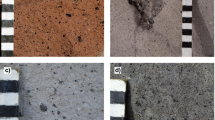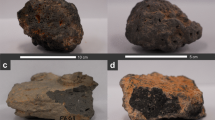Abstract
Exceptional exposure through a Permian intra-caldera ignimbrite fill within the 42 × 40 km Ora caldera (>1,290 km3 erupted volume) provides an opportunity to study welding textures in a thick intra-caldera ignimbrite succession. The ignimbrite succession records primary dense welding, a simple cooling unit structure, common crystallisation zones, and remarkably preserves fresh to slightly hydrated glass in local vitrophyre zones. Evidence for primary syn- and post-emplacement welding consists of (a) viscously deformed and sintered juvenile glass and relict shard textures; (b) complete deposit welding; (c) subtle internal welding intensity variations; (d) vitrophyre preserved locally at the base of the ignimbrite succession; (e) persistent fiamme juvenile clast shapes throughout the succession at the macroscopic and microscopic scales, defining a moderate to well-developed eutaxitic texture; (f) common undulating juvenile clast (pumice) margins and feathery terminations; (g) a general loss of deposit porosity; and (h) perlitic fracturing. A low collapsing or fountaining explosive eruption column model is proposed to have facilitated the ubiquitous welding of the deposit, which in turn helped preserve original textures. The ignimbrite succession preserves no evidence of a time break through the sequence and columnar joints cross-gradational ignimbrite lithofacies boundaries, so the ignimbrite is interpreted to represent a simple cooling unit. Aspect ratio and anisotropy of magnetic susceptibility (AMS) analyses through stratigraphic sections within the thick intra-caldera succession and at the caldera margin reveal variable welding compaction and strain profiles. Significantly, these data show that welding degree/intensity may vary in an apparently simple cooling unit because of variations in eruption process recorded in differing lithofacies. These data imply complex eruption, emplacement, and cooling processes. Three main crystallisation textural zones are identified in the ignimbrite succession: localised vitrophyre zones, widespread microcrystalline to sparsely spherulitic pseudomorphed vitriclastic textural zones, and thick granophyric zones. These zones record a typical spectrum from rapid to prolonged cooling. The non-uniform crystallisation patterns reflect variations in deposit thickness, the relative position of deposits within the larger ignimbrite succession, the type of substrate material, and the degree of confinement in the intra-caldera setting. We support previous work suggesting that traditional welding classifications (e.g. Smith, US Geological Survey Professional Paper 354-F 1960b) are most appropriate for use within altered and/or ancient ignimbrite successions.











Similar content being viewed by others
References
Allen RL (1988) False pyroclastic textures in altered silicic lavas, with implications for volcanic-associated mineralization. Econ Geol 83:1424–1446
Andrews GDM, Branney MJ (2011) Emplacement and rheomorphic deformation of a large, lava-like rhyolitic ignimbrite: Grey’s Landing, southern Idaho. Geol Soc Am Bull 123:725–743
Beddoe-Stephens B, Millward D (2000) Very densely welded, rheomorphic ignimbrites of homogeneous intermediate calc-alkaline composition from the English Lake District. Geol Mag 137:155–171
Borradaile G, Tarling DH (1981) The influence of deformation mechanisms on magnetic fabric in weakly deformed rocks. Tectonophysics 77:151–168
Branney MJ (1991) Eruption and depositional facies of the Whorneyside Tuff Formation, English Lake District: an exceptionally large-magnitude phreatoplinian eruption. Geol Soc Am Bull 103:886–897
Branney MJ, Kokelaar P (1992) A reappraisal of ignimbrite emplacement: progressive aggradation and changes from particulate to non-particulate flow during emplacement of high-grade ignimbrite. Bull Volcanol 54:504–520
Branney MJ, Kokelaar P (2002) Pyroclastic density currents and the sedimentation of ignimbrites. Geol Soc London, Memoir 27:143
Branney MJ, Kokelaar P, McConnell BJ (1992) The Bad Step Tuff: a lava-like rheomorphic ignimbrite in a calc-alkaline piecemeal caldera, English Lake District. Bull Volcanol 54:187–199
Cas RAF, Wright JV (1987) Volcanic successions: modern and ancient. Allen and Unwin, London
Cas RAF, Wright HMN, Folkes CB, Lesti C, Porreca M, Giordano G, Viramonte JG (2011) The flow dynamics of an extremely large volume pyroclastic flow, the 2.08 Ma Cerro Galán Ignimbrite, NW Argentina, and comparison with other flow types. Bull Volcanol 73:1585–1609
Cassinis G, Perotti CR, Ronchi A (2011) Permian continental basins in the Southern Alps (Italy) and peri-mediterranean correlations. Int J Earth Sci (Geol Rundsch) 101:129–157
Castellarin A, Cantelli L (2000) Neo-Alpine evolution of the Southern Eastern Alps. J Geodyn 30:251–274
Castellarin A, Vai GB (1982) Introduzione alla Geologia strutturale del Sudalpino. Guida alla Geologia del Sudalpino Centro-Orientale. Guida alla Geologia Rendiconti della Società Geologica Italiana, Bologna
Eichelberger JC, Koch FG (1979) Lithic fragments in the Bandelier Tuff, Jemez Mountains, New Mexico. J Volcanol Geotherm Res 5:115–134
Fisher RV, Schmincke H-U (1984) Pyroclastic rocks. Springer, Berlin
Freundt A, Schmincke H-U (1995) Eruption and emplacement of a basaltic welded ignimbrite during caldera formation on Gran Canaria. Bull Volcanol 56:640–659
Gifkins C, Allen RL, McPhie J (2005a) Apparent welding textures in altered pumice-rich rocks. J Volcanol Geotherm Res 142:29–47
Gifkins C, Herrmann W, Large R (2005b) Altered volcanic rocks: a guide to description and interpretation. CODES, Hobart
Giordano D, Nichols ARL, Dingwell DB (2005) Glass transition temperatures of natural hydrous melts: a relationship with shear viscosity and implications for the welding process. J Volcanol Geotherm Res 142:105–118
Jelínek V (1981) Characterisation of the magnetic fabric of rocks. Tectonophysics 79:63–67
Lofgren G (1971) Experimentally produced devitrification textures in natural rhyolitic glass. Geol Soc Am Bull 82:111–124
Marocchi M, Morelli C, Mair V, Klötzli U, Bargossi GM (2008) Evolution of large silicic magma systems: new U-Pb zircon data on the NW Permian Athesian Volcanic Group (Southern Alps, Italy). J Geol 116:480–498
Marti J, Diez-Gil JL, Ortiz R (1991) Conduction model for the thermal influence of lithic clasts in mixtures of hot gases and ejecta. J Geophys Res 96:21879–21885
Martín-Hernández F, Hirt AM (2003) The anisotropy of magnetic susceptibility in biotite, muscovite and chlorite single crystals. Tectonophysics 367:13–28
Maucher A (1960) Der permische Vulkanismus in Südtirol und das Problem der Ignimbrite. Geol Rundsch 49:487–497
McArthur AN, Cas RAF, Orton GJ (1998) Distribution and significance of crystalline, perlitic and vesicular textures in the Ordovician Garth Tuff (Wales). Bull Volcanol 60:260–285
McCann T, Kiersnowski H, Krainer K, Vozarova A, Peryt TM, Oplustil S, Wetzel A, Boulvain F, Dusar M, Torok A, Haas J, Tait J, Korner F (2008) Permian, vol 1. The Geology of Central Europe. Geological Society
McPhie J (1986) Primary and redeposited facies from a large-magnitude rhyolitic, phreatomagmatic eruption: Cana Creek Tuff, late-Carboniferous, Australia. J Volcanol Geotherm Res 28:219–250
McPhie J, Hunns SR (1995) Secondary welding of submarine, pumice-lithic breccia at Mount Chalmers, Queensland, Australia. Bull Volcanol 57:170–178
McPhie J, Doyle M, Allen R (1993) Volcanic textures: a guide to the interpretation of textures in volcanic rocks. CODES, Hobart
Morelli C, Marocchi M, Moretti A, Bargossi GM, Gasparotto G, Waele BD, Klötzli U, Mair V (2012) Volcanic stratigraphy and radiometric age constraints at the northern margin of a mega-caldera system: Athesian Volcanic Group (Southern Alps, Italy). GeoActa 11:1–43
Pioli L, Lanza R, Ort M, Rosi M (2008) Magnetic fabric, welding texture and strain fabric in the Nuraxi Tuff, Sardinia, Italy. Bull Volcanol 70:1123–1137
Quane SL, Russell JK (2005) Ranking welding intensity in pyroclastic deposits. Bull Volcanol 67:129–143
Ragan DM, Sheridan MF (1972) Compaction of the Bishop Tuff, California. Geol Soc Am Bull 83:95–106
Riehle JR, Miller TF, Paquereau-Lebti P (2010) Compaction profiles of ash-flow tuffs: modeling versus reality. J Volcanol Geotherm Res 195:106–120
Rottura A, Bargossi GM, Visona D, Tranne CA (1998) Petrological and geochemical evidence on the origin and significance of the Permian magmatism in the central-eastern Southern Alps, Italy. Memorie della Società Geologica Italiana 53:9–21
Schaltegger U, Brack P (2007) Crustal-scale magmatic systems during intracontinental strike-slip tectonics: U, Pb and Hf isotopic constraints from Permian magmatic rocks of the Southern Alps. Int J Earth Sci (Geologische Rundschau) 96:1131–1151
Smith RL (1960a) Ash flows. Geol Soc Am Bull 71:795–842
Smith RL (1960) Zones and zonal variations in welded ash flows. US Geological Survey Professional Paper 354-F
Smith TR, Cole JW (1997) Somers Ignimbrite Formation: Cretaceous high-grade ignimbrites from South Island, New Zealand. J Volcanol Geotherm Res 75:39–57
Walker GPL (1983) Ignimbrite types and ignimbrite problems. J Volcanol Geotherm Res 17:65–88
Willcock MAW, Cas RAF, Giordano G, Morelli C (2013) The eruption, pyroclastic flow behaviour, and caldera in-filling processes of the extremely large volume (>1290 km3), intra- to extra-caldera, Permian Ora (Ignimbrite) Formation, Southern Alps, Italy. J Volcanol Geotherm Res 265:102–126
Willcock MAW, Mattei M, Hasalová P, Giordano G, Cas RAF, Morelli C (2014) Flow behaviour in the intra-caldera setting: an AMS study of the large (>1290 km3) Permian Ora ignimbrite. In: Ort, M. H., Porreca, M.,Geissman, J. W (eds). The use of Palaeomagnetism and rock magnetism to understand volcanic processes. Geological Society of London Special Publication, 396 (in press)
Wilson CJN, Hildreth W (2003) Assembling an Ignimbrite: mechanical and thermal building blocks in the Bishop Tuff, California. J Geol 111:653–670
Acknowledgments
We would like to thank Patrick Hayman and Jocelyn McPhie for their helpful suggestions on the manuscript and the Ufficio Geologia e Prove materiali of the Provincia Autonoma di Bolzano Südtirol, especially Corrado Morelli for his logistical support. Furthermore, we thank journal reviewers Richard J Brown and Kelly Russell for their valuable feedback and useful critique on the manuscript.
Author information
Authors and Affiliations
Corresponding authors
Additional information
Editorial responsibility: P-S Ross
Rights and permissions
About this article
Cite this article
Willcock, M.A.W., Cas, R.A.F. Primary welding and crystallisation textures preserved in the intra-caldera ignimbrites of the Permian Ora Formation, northern Italy: implications for deposit thermal state and cooling history. Bull Volcanol 76, 819 (2014). https://doi.org/10.1007/s00445-014-0819-5
Received:
Accepted:
Published:
DOI: https://doi.org/10.1007/s00445-014-0819-5




